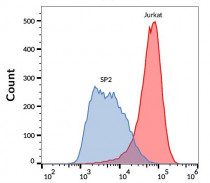ARG42430
anti-TSPAN7 antibody [B2D] (PE)
anti-TSPAN7 antibody [B2D] (PE) for Flow cytometry and Human
Overview
| Product Description | PE-conjugated Mouse Monoclonal antibody [B2D] recognizes TSPAN7 |
|---|---|
| Tested Reactivity | Hu |
| Tested Application | FACS |
| Specificity | The mouse monoclonal antibody B2D recognizes an extracellular epitope of CD231 (TALLA-1, tetraspanin 7), a transmembrane glycoprotein expressed in neuronal tissue and T-ALL. |
| Host | Mouse |
| Clonality | Monoclonal |
| Clone | B2D |
| Isotype | IgG1 |
| Target Name | TSPAN7 |
| Antigen Species | Human |
| Immunogen | Human T-ALL cell line THP-6. |
| Conjugation | PE |
| Alternate Names | A15; CCG-B7; Tetraspanin-7; Transmembrane 4 superfamily member 2; CD antigen CD231; TM4SF2; Tspan-7; Cell surface glycoprotein A15; TM4SF2b; CD231; DXS1692E; Membrane component chromosome X surface marker 1; T-cell acute lymphoblastic leukemia-associated antigen 1; TALLA-1; MRX58; MXS1 |
Application Instructions
| Application Suggestion |
|
||||
|---|---|---|---|---|---|
| Application Note | * The dilutions indicate recommended starting dilutions and the optimal dilutions or concentrations should be determined by the scientist. |
Properties
| Form | Liquid |
|---|---|
| Purification | Purified |
| Buffer | PBS and 15 mM Sodium azide. |
| Preservative | 15 mM Sodium azide |
| Storage Instruction | Aliquot and store in the dark at 2-8°C. Keep protected from prolonged exposure to light. Avoid repeated freeze/thaw cycles. Suggest spin the vial prior to opening. The antibody solution should be gently mixed before use. |
| Note | For laboratory research only, not for drug, diagnostic or other use. |
Bioinformation
| Database Links | |
|---|---|
| Gene Symbol | TSPAN7 |
| Gene Full Name | tetraspanin 7 |
| Background | The protein encoded by this gene is a member of the transmembrane 4 superfamily, also known as the tetraspanin family. Most of these members are cell-surface proteins that are characterized by the presence of four hydrophobic domains. The proteins mediate signal transduction events that play a role in the regulation of cell development, activation, growth and motility. This encoded protein is a cell surface glycoprotein and may have a role in the control of neurite outgrowth. It is known to complex with integrins. This gene is associated with X-linked cognitive disability and neuropsychiatric diseases such as Huntington's chorea, fragile X syndrome and myotonic dystrophy. [provided by RefSeq, Jul 2008] |
| Function | May be involved in cell proliferation and cell motility. [UniProt] |
| Cellular Localization | Membrane; Multi-pass membrane protein. [UniProt] |
| Calculated MW | 28 kDa |
Images (1) Click the Picture to Zoom In






